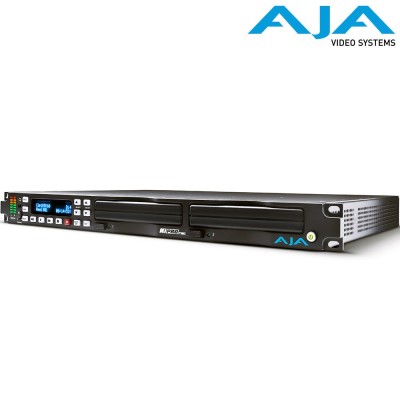Filter By
Video Inputs
Video Inputs
Outputs
Outputs
Entradas Audio
Entradas Audio
Salidas Audio
Salidas Audio
Codec / Ficheros
Codec / Ficheros
Data and Control
Data and Control
Comunes
Comunes
Rack Units
Rack Units
Stationary

Showing 1-1 of 1 item(s)
Stationary Video Recorders: Archiving and Mastering with Maximum Quality
From AVACAB Audiovisuales, we want to introduce you to an indispensable element in the post-production and archiving workflow of any studio or outside broadcast unit: Stationary Video Recorders. If you are looking for the most reliable way to capture the final program signal with lossless master quality and professional codec compatibility, these recorders are the essential tool.
Imagine you have just finished a complex multi-camera production, a live concert, or a corporate training session. The output signal (the 'Program') must be recorded with the highest possible fidelity for subsequent editing, archiving, or client delivery. A stationary recorder, often rack-mounted, ensures that the recording is impeccable, features redundancy, and uses codecs that retain all the color and detail information of the original signal.
What are Stationary Video Recorders?
A professional stationary video recorder is a hardware device designed to receive a high-quality video signal (typically SDI or HDMI) and store it digitally on high-speed media (SSD, CFast cards, HDD) using professional-grade codecs. They are called 'stationary' because they are designed for fixed installation, usually mounted in equipment racks in control rooms or production vehicles, and focus on the maximum quality and reliability of the 'Master' recording.
Essential Features of Stationary Recorders
These devices are distinguished by their robustness, recording quality, and integration into professional workflows:
Broadcast-Grade Connectivity and Formats
High-Speed SDI Inputs: The primary connectivity is via SDI connectors (3G-SDI, 6G-SDI, or 12G-SDI) to capture resolutions up to 4K UHD with low latency and maximum bandwidth. They also include HDMI inputs for compatibility with prosumer equipment.
Mastering Codecs: Support minimal or lossless compression codecs such as Apple ProRes, Avid DNxHR/HD, or uncompressed formats, which are essential for post-production as they retain maximum color information (4:2:2, 4:4:4) and dynamic range.
Reliability and Operability
Redundant Recording (Dual Media): Most professional models allow simultaneous recording to two cards or drives. This ensures that if one medium fails or fills up, the recording is not interrupted (failover), guaranteeing the integrity of the main take.
Rack-Mountable Design: Their form factor (generally 1U or 2U) facilitates integration into standard equipment racks in control rooms or production vehicles, ensuring a clean and organized work environment.
Quality Monitoring: Offer monitoring outputs with information overlays (timecode, audio meters, recording status), and some models include integrated preview screens.
Quality Monitoring: Offer monitoring outputs with information overlays (timecode, audio meters, recording status), and some models include integrated preview screens.
Advanced Management and Synchronization
Timecode and Genlock: Total integration with studio infrastructure by accepting reference signals (Genlock) and external timecode. This is vital in multi-camera productions where the synchronization of all recordings is critical.
Remote Control: Accept control via protocols such as RS-422, or even Ethernet (Web/API), allowing recording to be started and stopped from the control room or a video switcher.
Additional Functionalities
Slow-Motion/Instant Replay: Some models are enabled for slow-motion playback or instant replay, essential in sports production.
Metadata and EDL Recording: Ability to record metadata (clip information) or generate Edit Decision Lists (EDL) directly onto the media, streamlining ingest into Non-Linear Editing (NLE) systems.
Key Applications of Stationary Recorders
These devices are the backbone of high-quality capture in various sectors:
Post-Production and Film
Master Capture: Recording of the final program version (Master Tape/File) for distribution or archiving, using codecs that minimize quality loss.
Backup and Archiving: Creation of high-quality preservation files for libraries and studios.
Broadcast and Live Production
Outside Broadcast (OB) Units: On-site recording of all camera sources and the final program during major sports events or concerts.
News Studios and Soap Operas: Recording of studio takes with broadcast quality for subsequent editing.
Media Asset Management (MAM) Platforms: Quick and efficient ingest of recorded content in formats compatible with media management systems.
Fixed Installations and Pro AV
Conference Rooms and Auditoriums: High-quality recording of presentations and seminars for later distribution.
Simulators and Laboratories: Capturing high-resolution visual data for analysis or educational purposes.
Stationary Recorders vs. Portable Recorders
The main difference lies in application and reliability:
Stationary Recorders: Prioritize redundancy, rack integration, mastering codecs, and centralized remote control. They are the choice for critical 'Master' recording in studio or broadcast environments.
Portable Recorders: Designed to be lightweight and camera-mounted or used in the field (Field Recorders). While offering good quality, their focus is on mobility and field recording, not centralized master program recording.
At AVACAB Audiovisuales, we offer stationary recorders from leading brands that guarantee your most valuable content is captured and archived with maximum quality and reliability.
Ensure every minute of your production with maximum master fidelity!
Ensure every minute of your production with maximum master fidelity!
